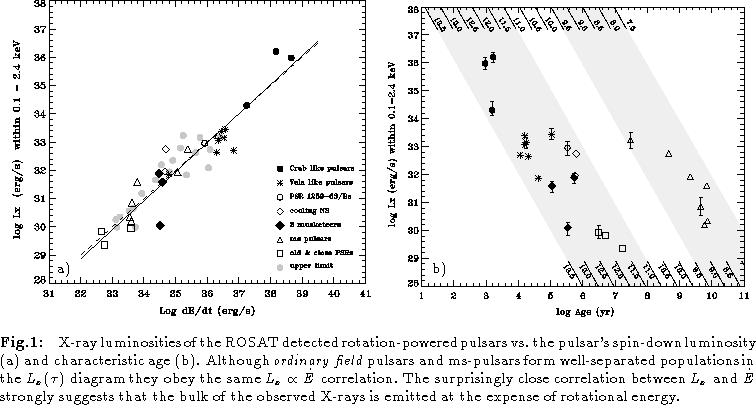The X-ray Luminosity of rotation-powered Neutron Stars
The nearly 750 radio pulsars known so far are interpreted as rapidly
spinning and strongly magnetized neutron stars which are radiating at
the expense of rotational energy. With ROSAT and ASCA, 27 of these
pulsars have been detected in the soft X-ray domain, representing a
wide range of ages ( ![]() yrs), magnetic field
strength (
yrs), magnetic field
strength ( ![]() G) and spin periods (1.6 - 530 ms). Despite these
dispersions in parameters Becker & Trümper (1997) found that the
X-ray luminosity of the detected pulsars is closely correlated with the
pulsar's rotational energy loss
G) and spin periods (1.6 - 530 ms). Despite these
dispersions in parameters Becker & Trümper (1997) found that the
X-ray luminosity of the detected pulsars is closely correlated with the
pulsar's rotational energy loss ![]() .
.
Figure 1a depicts the X-ray luminosities of all 26 pulsars measured in
the ROSAT band as a function of their rotational energy loss. For the
cooling neutron stars we have plotted the luminosities derived for their
non-thermal component. Fitting a ![]() distribution to the
data we find
distribution to the
data we find ![]() and a correlation coefficient of r = 0.946.
Adopting b=1 the efficiency of conversion is
and a correlation coefficient of r = 0.946.
Adopting b=1 the efficiency of conversion is ![]() ,
indicated by the dashed-line.
,
indicated by the dashed-line.
Another way to look to the sample of the X-ray detected rotation-powered
pulsars is shown in Figure 1b where the X-ray luminosity is plotted as a
function of the pulsar's characteristic age. Assuming the standard picture
of magnetic braking we find ![]() . The corresponding
. The corresponding
![]() curves are indicated. All pulsars lie close to the braking curves calculated
for their respective polar magnetic fields.
curves are indicated. All pulsars lie close to the braking curves calculated
for their respective polar magnetic fields.
The strong correlation suggests that the prime energy source of the X-ray emission
is the pulsar's rotational energy. In particular the millisecond pulsars, which are
separate from the majority of ordinary field pulsars, obey the same linear relationship
with the same X-ray efficiency as the Crab type pulsars, indicating that their emission
is mainly due to magnetospheric processes. The result is in line with the occurrence
of power-law spectra and the similarity between the radio and X-ray pulse profiles
(Becker & Trümper et al. 1997 in prep.).
Becker,W., Trümper, J., A&A, 1997, 326, 682-691
